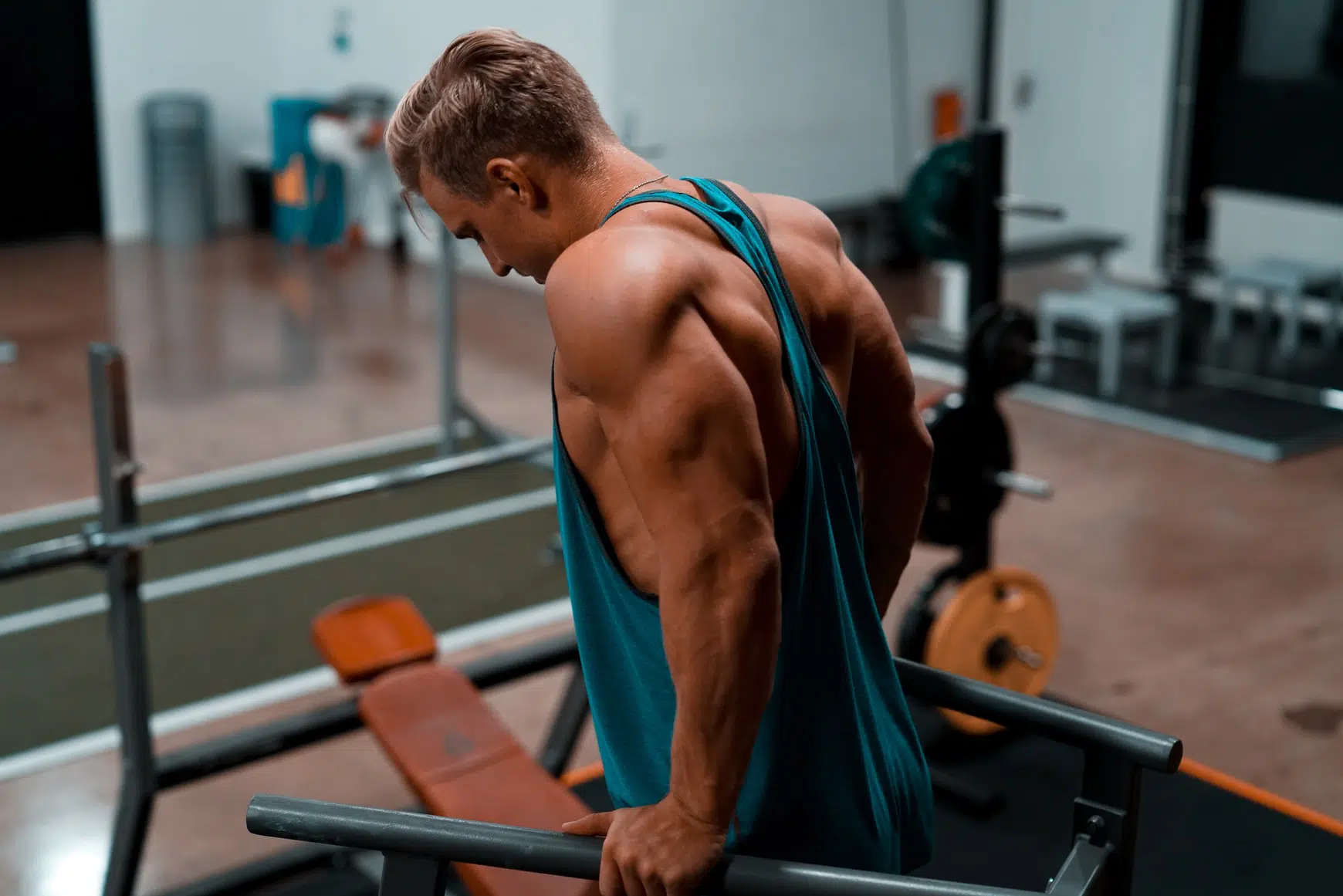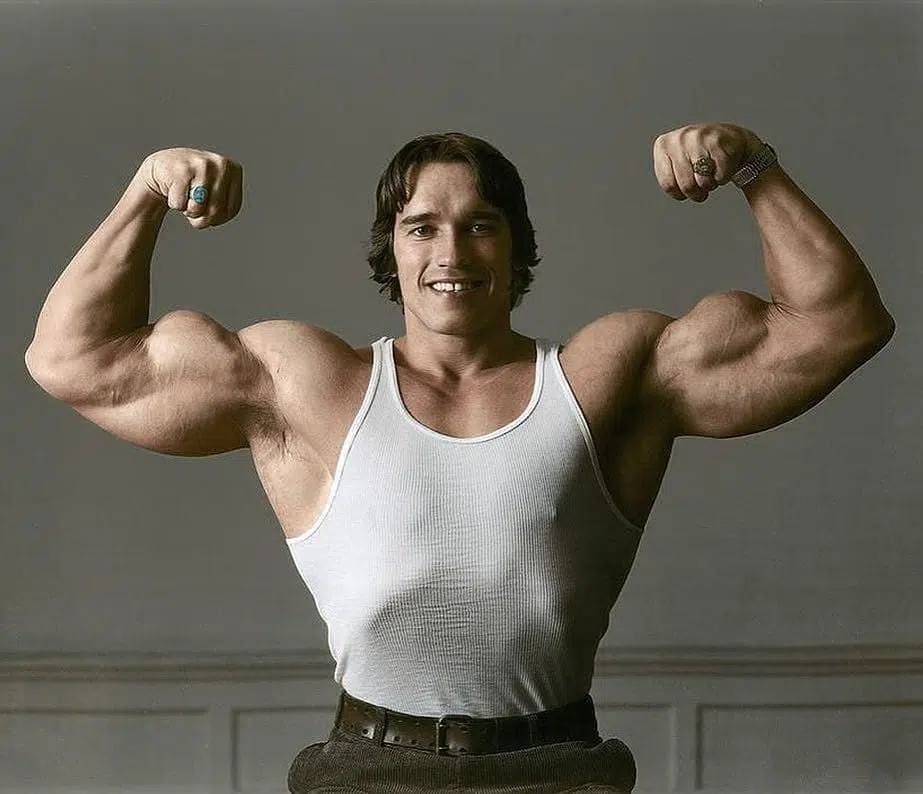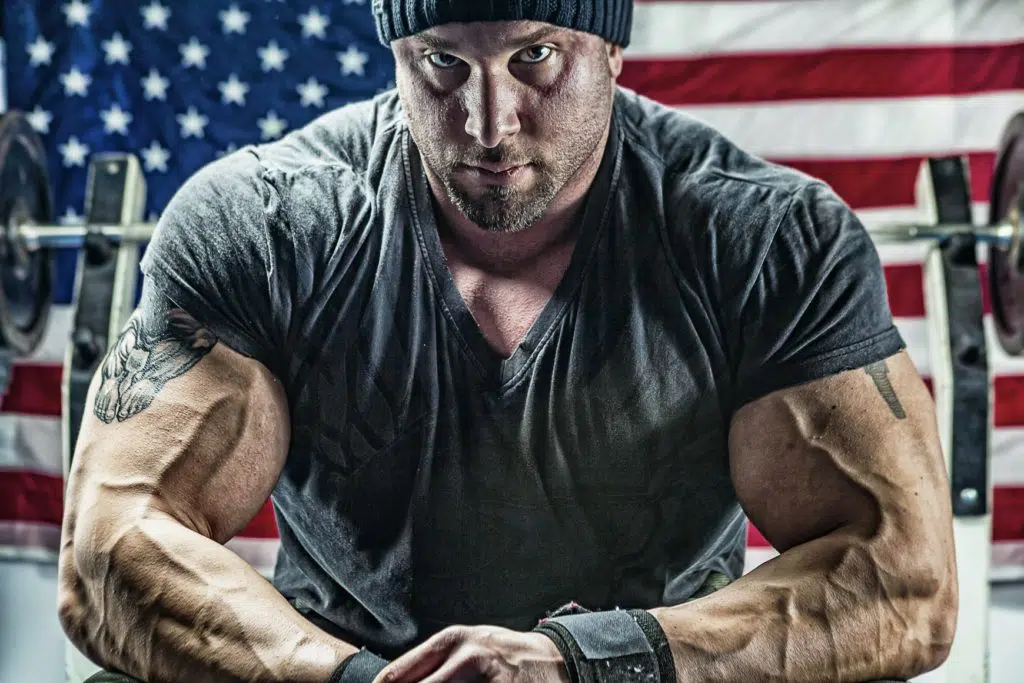
“There are also a lot of options if you want to focus on your arms. A program specifically for arms? Yes, you’re not the first to think of it!”
It’s no secret that men want bigger arms. It’s also one of the best body parts to train and one of the quickest to recover. If you’re a hardgainer, you probably have skinny arms and you want to build them up and shape them to something a little more aesthetic. However, there are a lot of myths surrounding training in general that can lead newbies down the wrong path. We’re going to go over the muscular anatomy of the arm and bust a couple of those myths. This is: How to Build Bigger Arms for Hardgainers.
Muscles of the arm
Immediately the bicep and triceps come to mind if we talk about arm muscles, but there are a lot more to consider. Let’s begin at the top.
Deltoids
Your shoulder muscles are called your deltoids, and each shoulder is made up of three deltoid muscles. The anterior deltoid, lateral deltoid, and posterior deltoid, meaning front, side, and back, respectively. Your anterior and lateral delts often get a lot of work through any pushing movement such as the bench press or overhead press. Your rear delts will get a lot of work through any pulling movements like a row or pull-ups.
Triceps Brachii
Moving down the posterior side of the arm, we have the triceps brachii. Now, we should all know that the triceps muscle is made of three muscles, hence the “tri” in the name. And we should all know what it does. If you extend your arm out straight, you should be able to feel your triceps on the back of your arm. The triceps muscle, by contraction, moves your forearm away from your upper arm. This is called extension.
The bottom of the muscles comes together and attaches to your forearm, right after your elbow. If you extend your arm now, you should be able to understand how the triceps contract, sort of pull and extend your forearm.
The triceps have three heads, referred to as the long, lateral, and medial heads. All this means is that the muscle has three parts that attach at different spots on your bones. The lateral and medial heads originate above and below the radial groove of your upper arm, or humerus. The long head of the triceps is the most interesting as it actually originates from the scapula. That means that the long head goes all the way from your scapula to your forearm, crossing two joints. When a muscle crosses two joints, it is referred to as a biarticular muscle. We will circle back to this later.
Brachialis
On the side of the upper arm, we have a muscle called the brachialis. We know where the triceps is and you probably know where your bicep is, so right between them, on the outside of your upper arm is the brachialis. This muscle is kind of cool in a way because it sits beneath the biceps muscle.
Its job is very similar to the biceps, simply providing flexion of the elbow. We have three muscles on the back of our arm to provide extension and three on the front for flexion. The brachialis is like the third bicep. That’s one way of looking at it, anyways.
Biceps Brachii
Ah, the biceps. When you lift your arm up in the air to flex, you’re likely flexing your biceps. The biceps muscle provides flexion- that brings your forearm closer to your upper arm. If you are having a drink of water, the biceps bring the glass closer to your mouth. The biceps also contribute to supination and pronation of the forearm, unlike the brachialis.
Of course, “bi” means two and so we are describing two muscles. The biceps inserts on your forearm, while the top is split into two heads. The long head originates from the top of your humerus, and the short head actually originates from your scapula, on a small bone called the coracoid process. Once again, we have biarticular muscles.
Forearm muscles
The forearm muscles mostly consist of the brachioradialis, anconeus, and multiple flexors, pronators, and extensors. A lot of this is wrist action, and that’s why some people like to do wrist curls in the gym to grow their forearms.
If you hold your hand in a fist, so the back of your hand is facing to the sky, and flex your bicep, you are doing a forearm curl. The big forearm muscle you see that’s squishing against your bicep when you do this is called the brachioradialis. This is also a flexor and causes supination and pronation of the forearm.
Hopeful you have a pretty good basic idea of the muscle in your arm. My apologies if that was a little anatomically heavy, but it was necessary to move forward.
I want biceps like Arnold

Arnold Schwarzenegger is the global mascot for bodybuilding for many reasons but the one that stands out for many is his short full-bellied biceps.
If you look closely at his biceps, they are quite short but have a very tall “peak”. The peak is desirable for bodybuilding and makes the muscle look larger. I’ve had a lot of questions regarding muscle shape, such as: “What exercises build this shape of bicep?”.
The shape of our muscles is based entirely on our genetics. A muscle attaches to a tendon and where exactly on that tendon it attaches, varies greatly. And this is exactly the case for Arnold’s bicep peaks. The bicep must insert onto the tendon and sometimes it will insert further down, creating a longer skinnier bicep. In Arnold’s case, the muscle inserts high up, creating a shorter and fuller-looking muscle belly.
This is one of those things that people are referring to when they say that bodybuilding is all about genetics. Unfortunately, there is no way to grow the peak of your bicep or change the shape of any muscle, outside of medical procedures.
I mention this more in another article called Why do skinny guys have abs? We discuss the size, shape, and symmetry of abs.
Why are my arms small to begin with?
This might seem like a silly question but there’s actually more to it. Obviously, your arms are going to be smaller if you don’t eat a lot or you don’t work out.
Even if this is the case, some may notice that their friends or colleagues who weigh the same and also don’t exercise, have larger and sometimes even muscular arms. Again this comes down to genetics. Some people tend to hold fat in their arms, making them appear larger, or fill out the sleeves of a t-shirt more easily. And then there are the lucky ones who tend to just be more muscular than the average person.
The good news is that you can always grow your arm muscles. So you may have small arms. I had small arms, and I have long biceps with a low insertion, making them look long and skinny. Over time, I’ve been able to build them up and grow them.
Finding a good program
If you’re hitting the gym and you don’t have a program you’re following, go find one right now! Almost any program is better than no program.
There are a lot of different programs online for free that you can start right now. There are also a lot of options if you want to focus on your arms. A program specifically for arms? Yes, you’re not the first to think of it!
How to adjust volume and frequency

Most of this has been aimed toward newbies, but if you’ve been training for a few years and you’re eager to grow your arms, you may want to consider manipulating your training volume or frequency.
Most lifters will experience a plateau of some sort after the newbie gains are gone, and that’s fine. All a plateau is, is a learning opportunity.
Training volume is simply the total amount of work you do in a workout. Some of us respond to more volume than others do, some less. If you’re having difficulty adding size to a muscle group, consider adding some extra sets in and go from there. Your body will get used to the training stimulus, so you must implement progressive overload.
Training frequency is the term used to describe how often you work a specific muscle group, usually per week. This is different from volume, even though it can sometimes achieve the same outcome. Manipulating the training frequency can help you break through a plateau. You may even lower the volume and increase the frequency. An example of this would be to reduce the number of sets you perform on a muscle group and spread those sets out over 3 workouts instead of 2.
That is just an example. In most cases, you would increase both variables.
You can goof around and find something that yields gains for you, or you can first pick a program and pay close attention to the volume and frequency, and record the results. Both methods will help you better understand how your body responds to different stimuli.
Explore new training techniques
If you’re trying to build your arms, exploring new training techniques may help add on some size, for two main reasons.
First, implementing negatives or isometric contractions can apply an unfamiliar training stimulus to your muscles. This can result in a small growth spurt due to the novelty of the technique or perhaps you’ll train a muscle you weren’t hitting before.
Another reason this could help growth is that training your arms can get boring, and adding new challenges should inspire one to grow and train harder.
Ok, so a few different techniques to consider here are negatives, isometrics, pyramids, drop sets, and let’s say assisted reps. Very quickly, we’ll go over each one.
Negatives
This is when you perform the eccentric portion of a movement, and either skip the concentric portion or “cheat” it. An example here would be to begin a pull-up from the top, slowly letting yourself down. When you get to the bottom, jump or climb back up to the top, instead of actually pulling yourself back up.
Isometric Reps
“Iso” means isolation. This is a contraction without movement. This can be extra beneficial if you have a sticking point or there’s a difficult portion of a range of motion for you like if you have trouble at the bottom of a squat, you can address that weakness by isometrically training the bottom of the squat. To continue with the pull-up example here, an isometric rep would be where you get to the top of the pull-up and hold it either for a set amount of time or as long as you can.
Pyramids
Pyramid sets can be a great way to mix up your training and have some fun. This is when we structure a set and rep scheme to go from a single rep up to a much larger amount of reps. For example, you would start with a single pull-up, then the next set would be two pull-ups, then three, so on and so forth. I like pyramid sets best when combined with bodyweight exercises such as the pull-up or dips or push-ups.
Drop set
A drop set is similar to pyramid sets, in a way. But this time you’ll start with a heavier weight and perform a full set of reps, likely somewhere in the 8-12 rep range. You will go either to failure or close to failure, then drop the weight by 10-20% and repeat the set. You will keep doing this until you get to a lighter load and you can perform many reps. Trust me, you’ll know when the set is over because you’re going to feel it. For an arm exercise, I would recommend trying this with dumbbell curls.
How to guarantee growth

Few things are actually required to build muscle. If you can guarantee these things, you’ll be rewarded with gains, every time.
The first is food. A caloric surplus, to be specific. You absolutely must be eating a surplus of calories to build muscle. It doesn’t have to be a lot, but it is a requirement. And you should definitely be eating enough protein. That’s 0.8-1.0g/lb of body weight, by the way.
The second is a training stimulus. For us, that’s resistance training or lifting weights.
The third is consistency paired with progressive overload. You need to commit to eating and lifting, and you have to slowly increase the stimulus over time. That just means that you need to add weight or reps the stronger you become.
If you can guarantee these three tenets, you will get bigger arms. Even if you’re a hardgainer.
Thank you for making it to the end of the article, I appreciate you taking the time to read this. If you want to support me or support the website, consider sharing this post or telling your friends about us.